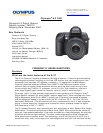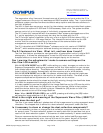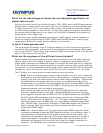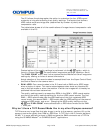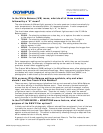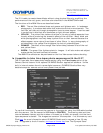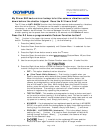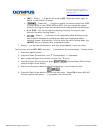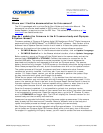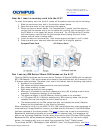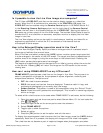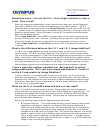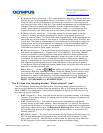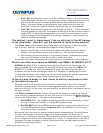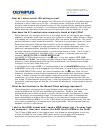
DIGITAL TECHNICAL SUPPORT
OLYMPUS IMAGING AMERICA INC.
(888) 553-4448
http://support.olympusamerica.com
©2008 Olympus Imaging America Inc. Page 3 of 26 Last updated on February 28, 2008
What are the advantages of lenses that are designed specifically for
digital camera use?
Although the small size of the individual pixels in CCD, CMOS, and Live MOS image sensors
enables them to capture even more detail than film, the sensitivity of the sensor elements
is highly directional. That is, they respond best to light that strikes the elements straight
on. With lenses designed for use with film, the light rays passing through the periphery of
the lens strike the image sensor at an angle, and this tends to degrade picture quality at
the periphery of the image area.
On the other hand, lenses developed specifically for digital camera use are designed to
match the imaging characteristics of CCD, CMOS and Live MOS sensors, ensuring high
image quality at both the center and the periphery of the frame.
Is the E-3 body splashproof?
The construction and design of the E-3 features seals on all of the controls and ports and
around the flash component, making the E-3 body splashproof and dustproof. When used
with Olympus Zuiko
®
Digital Super High-Grade and High-Grade lenses, the E-3 can be used
safely in dust storms, rain and snow.
What are the purposes of the different record modes?
Record modes allow photographers to quickly and conveniently vary the quality settings
used to capture and save images in-camera. While it is possible to always shoot at the
higher-quality settings and process the images into smaller file sizes later with a computer,
it may be more convenient in some situations to use other than the higher-quality settings.
For example, it may be preferable to shoot using a lower-quality setting when the shots are
intended for use on the Internet, where small file size is more important than rich detail.
The E-3 offers nine record modes, whose benefits are outlined below.
• RAW: This is the highest-quality record mode available in the E-3, and it allows the
photographer the most creative control in post-production. Images are saved to the
memory card from the camera sensor with minimal image processing. Factors such
as white balance, sharpness, contrast and color are unchanged so they can be
modified later on a computer. Some photographers prefer to shoot RAW all the time
for all subjects, while others may shoot RAW in situations that pose complicated
exposure problems, such as wedding photography.
Each camera manufacturer has its own version of RAW tailored to its cameras;
therefore, special software is required to process RAW files and convert them to
other image file formats such as JPEG and TIFF. OLYMPUS Master
®
and OLYMPUS
Studio
®
contain RAW processing and conversion software for the Olympus RAW
format, which bears the file extension *.orf. Third-party imaging software and
operating systems may use RAW plug-ins or upgrades to process Olympus RAW
files. Without them, they would not be able to read RAW images from Olympus
digital cameras. Most photo kiosks, printers and photo labs cannot read
unconverted RAW images.
• JPEG: Four record modes in the E-3 create compressed JPEG image files. When
the camera processes a captured JPEG image and saves it to the memory card, it
uses algorithms to discard some of the data to make the file size smaller. The
process of mathematically reducing a file’s size by discarding some of its data is
called compression. The greater the compression ratio, the more data will be
discarded and the smaller will be the file size. When the image is opened on a
computer, the JPEG algorithms reconstruct the discarded data.



